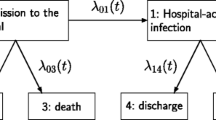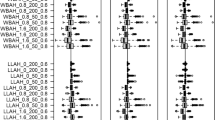Abstract
Purpose
To illustrate modern survival models with focus on the temporal dynamics of intensive care data. A typical situation is given in which time-dependent exposures and competing events are present.
Methods
We briefly review the following established statistical methods: logistic regression, regression models for event-specific hazards and the subdistribution hazard. These approaches are compared by showing advantages as well as disadvantages. All methods are applied to real data from a study of day-by-day ICU surveillance.
Results
Standard logistic regression ignores the time-dependent nature of the data and is only a crude approach. Cumulative hazards and probability plots add important information and provide a deep insight into the temporal dynamics.
Conclusion
This paper might help to encourage researchers working in hospital epidemiology to apply adequate statistical models to complex medical questions.




Similar content being viewed by others
Abbreviations
- NP:
-
Nosocomial pneumonia
- ICU:
-
Intensive care unit
- PAF:
-
Population attributable fraction
- OR:
-
Odds ratio
- HR:
-
Hazard ratio
- CI:
-
Confidence interval
- PHREG:
-
Proportional hazards regression
References
Cosgrove S, Carmeli Y (2003) The impact of antimicrobial resistance on health and economic outcomes. Clin Infect Dis 36:1433–1437
Song X, Srinivasan A, Plaut D, Perl T (2003) Effect of nosocomial vancomycin-resistant enterococcal bacteremia on mortality, length of stay, and costs. Infect Control Hosp Epidemiol 24:251–256
Tacconelli E, Pop-Vicas A, D’Agata E (2006) Increased mortality among elderly patients with meticillin-resistant Staphylococcus aureus bacteraemia. J Hosp Infect 64:251–256
Vandewoude K, Blot S, Benoit D, Colardyn F, Vogelaers D (2004) Invasive aspergillosis in critically ill patients: attributable mortality and excesses in length of ICU stay and ventilator dependence. J Hosp Infect 56:269–276
Shorr A, Combes A, Kollef M, Chastre J (2006) Methicillin-resistant Staphylococcus aureus prolongs intensive care unit stay in ventilator-associated pneumonia, despite initially appropriate antibiotic therapy. Crit Care Med 34:700–706
Asensio A, Torres J (1999) Quantifying excess length of postoperative stay attributable to infections: a comparison of methods. J Clin Epidemiol 52:1249–1256
Samore M, Shen S, Greene T, Stoddard G, Sauer B, Shinogle J, Nebeker J, Harbarth S (2007) A simulation-based evaluation of methods to estimate the impact of an adverse event on hospital length of stay. Med Care 45:S108–S115
Antonelli M, Azoulay E, Bonten M, Chastre J, Citerio G, Conti G, De Backer D, Lemaire F, Gerlach H, Groeneveld J, Hedenstierna G, Macrae D, Mancebo J, Maggiore S, Mebazaa A, Metnitz P, Pugin J, Wernerman J, Zhang H (2008) Year in review in intensive care medicine, 2007. III: ethics and legislation, health services research, pharmacology and toxicology, nutrition and paediatrics. Intensive Care Med 34:598–609
Andrews P, Azoulay E, Antonelli M, Brochard L, Brun-Buisson C, De Backer D, Dobb G, Fagon J, Gerlach H, Groeneveld J, Macrae D, Mancebo J, Metnitz P, Nava S, Pugin J, Pinsky M, Radermacher P, Richard C (2007) Year in review in Intensive Care Medicine, 2006. II: infections and sepsis, haemodynamics, elderly, invasive and noninvasive mechanical ventilation, weaning, ARDS. Intensive Care Med 33:214–229
Mayhall C (2004) Hospital epidemiology and infection control, Chap 93. Lippincott Williams & Wilkins, Philadelphia
Schulgen G, Kropec A, Kappstein I, Daschner F, Schumacher M (2000) Estimation of extra hospital stay attributable to nosocomial infections: heterogeneity and timing of events. J Clin Epidemiol 53:409–417
Putter H, Fiocco M, Geskus R (2007) Tutorial in biostatistics: competing risks and multi-state models. Stat Med 26:2389–2430
Beyersmann J, Gastmeier P, Grundmann H, Baerwolff S, Geffers C, Behnke M, Rueden H, Schumacher M (2006) Use of multistate models to assess prolongation of intensive care unit stay due to nosocomial infection. Infect Control Hosp Epidemiol 27:493–499
Schumacher M, Wangler M, Wolkewitz M, Beyersmann J (2007) Attributable mortality due to nosocomial infections: a simple and useful application of multistate models. Methods Inf Med 46:595–600
Wolkewitz M, Vonberg R, Grundmann H, Beyersmann J, Gastmeier P, Baerwolff S, Geffers C, Behnke M, Rueden H, Schumacher M (2008) Risk factors for the development of nosocomial pneumonia and mortality on intensive care units: application of competing risks models. Crit Care 12:R44
Resche-Rigon M, Azoulay E, Chevret S (2006) Evaluating mortality in intensive care units: contribution of competing risks analyses. Crit Care 10:R5. doi:10.1186/cc3921
Gastmeier P, Geffers C, Sohr D, Dettenkofer M, Daschner F, Rueden H (2003) Five years working with the German nosocomial infection surveillance system (Krankenhaus Infektions Surveillance System). Am J Infect Control 31:316–321
Garner J, Jarvis W, Emori T, Horan T, Hughes J (1988) CDC definitions for nosocomial infections, 1988. Am J Infect Control 16:128–140
Beyersmann J, Schumacher M (2008) Time-dependent covariates in the proportional subdistribution hazards model for competing risks. Biostatistics 9:765–776
Hougaard P (1999) Multi-state models: a review. Lifetime Data Anal 5:239–264
Klein J, Moeschberger M (2003) Survival analysis: techniques for censored and truncated data. Springer, New York
Armitage P, Colton T (1998) Encyclopedia of biostatistics. Wiley, Chichester, pp 2968–2972
Annesi I, Moreau T, Lellouch J (1989) Efficiency of the logistic regression and Cox proportional hazards models in longitudinal studies. Stat Med 8:1515–1521
Callas P, Pastides H, Hosmer D (1998) Empirical comparisons of proportional hazards, poisson, and logistic regression modeling of occupational cohort data. Am J Ind Med 33:33–47
de Irala-Estevez J, Martinez-Concha D, Diaz-Molina C, Masa-Calles J, Serrano del Castillo A, Fernandez-Crehuet Navajas R (2001) Comparison of different methodological approaches to identify risk factors of nosocomial infection in intensive care units. Intensive Care Med 27:1254–1262
Fine J, Gray RJ (1999) A proportional hazards model for the subdistribution of a competing risk. J Am Stat Assoc 94:496–509
R Development Core Team (2005) R: A language and environment for statistical computing. R Foundation for Statistical Computing, Vienna, Austria. URL: http://www.R-project.org, ISBN 3-900051-07-0
Schoenfeld D (2006) Survival methods, including those using competing risk analysis, are not appropriate for intensive care unit outcome studies. Crit Care 10:103. doi:10.1186/cc3949
Chevret S (2001) Logistic or Cox model to identify risk factors of nosocomial infection: still a controversial issue. Intensive Care Med 27:1559–1560
van Walraven C, Davis D, Forster A, Wells G (2004) Time-dependent bias was common in survival analyses published in leading clinical journals. J Clin Epidemiol 57:672–682
Beyersmann J, Gastmeier P, Wolkewitz M, Schumacher M (2008) An easy mathematical proof showed that time-dependent bias inevitably leads to biased effect estimation. J Clin Epidemiol 61:1216–1221
Barnett A, Graves N (2008) Competing risks models and time-dependent covariates. Crit Care 12:134. doi:10.1186/cc6840
Wolkewitz M, Beyersmann J, Gastmeier P, Schumacher M (2008) Regression modelling in hospital epidemiology: a statistical note. Crit Care 12:427. doi:10.1186/cc6852
Acknowledgments
We thank the four anonymous reviewers for their comments and Caroline Mavergames for checking the final manuscript for English language grammar and style. They helped to improve the manuscript. This project was funded by the Deutsche Forschungsgemeinschaft DFG, project FOR 534.
Author information
Authors and Affiliations
Corresponding author
Electronic supplementary material
Below is the link to the electronic supplementary material.
Rights and permissions
About this article
Cite this article
Wolkewitz, M., Beyersmann, J., Gastmeier, P. et al. Modeling the effect of time-dependent exposure on intensive care unit mortality. Intensive Care Med 35, 826–832 (2009). https://doi.org/10.1007/s00134-009-1423-6
Received:
Accepted:
Published:
Issue Date:
DOI: https://doi.org/10.1007/s00134-009-1423-6




